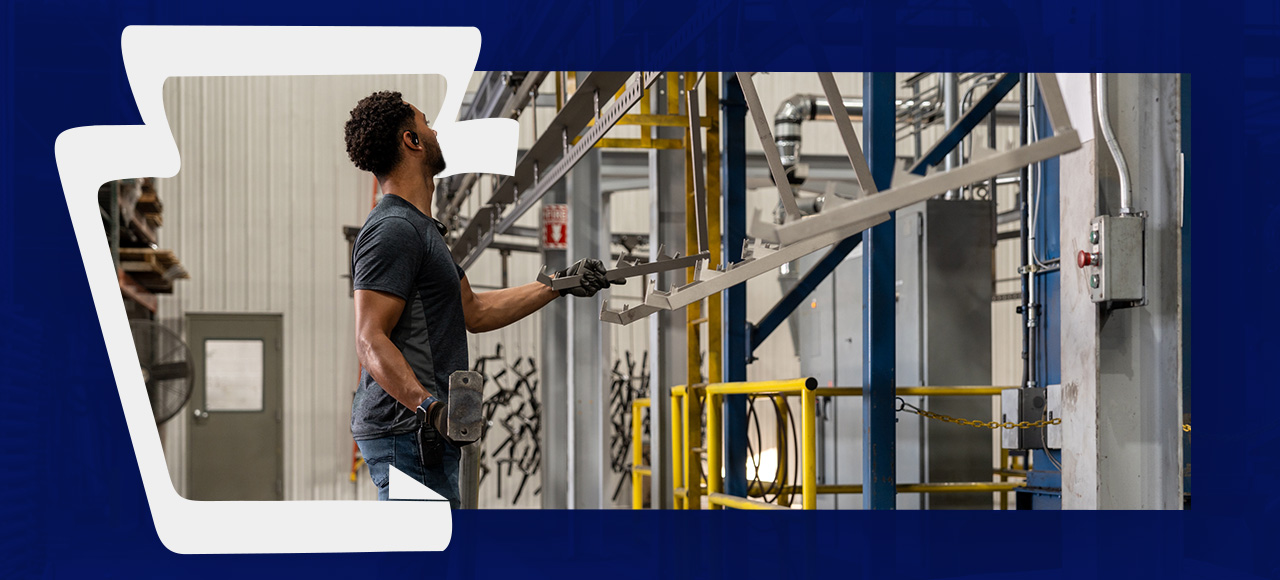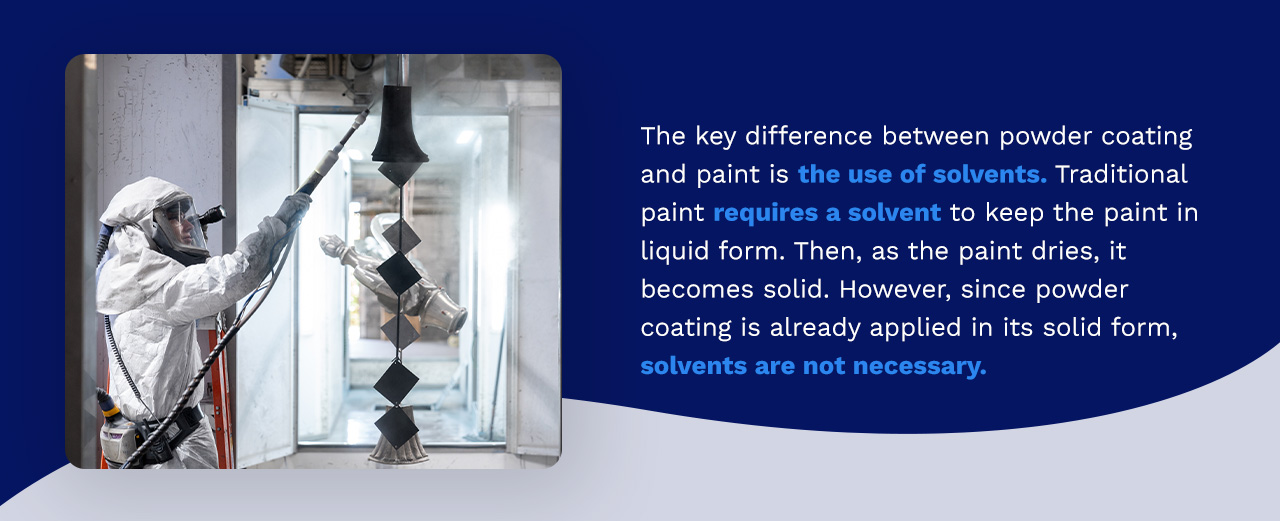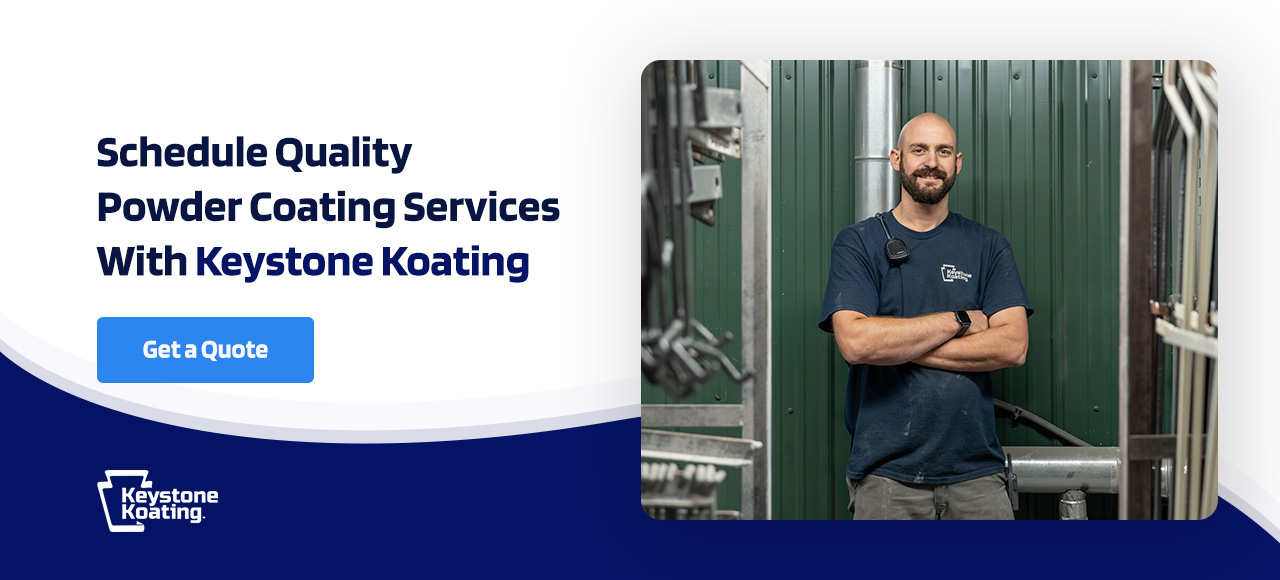
Whether you are deciding between paint or powder coating or you need to identify the current coating on a surface, it’s important to be informed of the differences between these two substances. But can you really tell the difference between paint and powder coating? While a quick glance is not enough to determine which coating material was used, there are ways to identify them. Learn more about the identifying factors of both paint and powder coating with our complete guide below.
What Is Powder Coating?
Powder coating is used in various applications for its durable, protective and aesthetic finishes. It works by applying dry powder to a charged surface. This electrostatic charge allows the powder to cling to the surface. High temperatures are used to cure or set the coating.
There are two general types of powder coating — thermoset and thermoplastic. Thermoset powder coatings undergo an irreversible chemical change, making the curing process permanent. This means this powder coating will not melt under extreme temperatures. This powder coating option is extremely resistant to scratches even though it is applied in thinner layers than thermoplastic powder coatings.
Taking a look at the other powder coating option, thermoplastic powder coatings do not go through a chemical change. Thermoplastic melts under high temperatures to coat the surface and hardens as it cools. This option does not require a curing process, but it is important to note that it can soften or remelt if it comes in contact with high temperatures.
The best type of powder coating to use will depend on your specific application needs.
What Is the Main Difference Between Powder Coating and Paint?
The key difference between powder coating and paint is the use of solvents. Traditional paint requires a solvent to keep the paint in liquid form. Then, as the paint dries, it becomes solid. However, since powder coating is already applied in its solid form, solvents are not necessary. Solvents can often be toxic, as they include volatile organic compounds (VOCs). Powder coating does not emit VOCs, making powder coating a safer and more eco-friendly option by comparison.
Does Powder Coating Look Like Paint?
Powder coating can look like paint, especially to the untrained eye. Both paint and powder coating are available in matte, satin, gloss, semigloss and high-gloss finishes, making it hard to distinguish these materials with only a quick glance. While powder coating and paint do look similar, there are some tell-tale signs that distinguish them.
How to Identify Powder Coating From Paint
Closely look at the following characteristics to determine if something is powder coated or painted. If you’re still unable to confidently distinguish the two, reach out to a reputable powder coating company for a consultation. An experienced technician should be able to help identify if a product or material has received powder coating.
Texture
While both paint and powder coating can achieve a range of finishes from matte to high-gloss, they are better suited to different types of finishes. Powder coating is ideal for a matte finish, while paint is ideal for high-gloss finishes. Additionally, powder coating has a rougher, more textured finish compared to traditional paint. However, a smoother finish can be achieved by using thicker layers of powder coating.
Evenness of Application
While powder coating has a grainy texture, it actually applies more evenly than paint. Powder coating is able to naturally achieve an even coat due to the charged particles clinging to the grounded metal. Even for complicated or uniquely shaped surfaces, powder coating can achieve an even finish. Meanwhile, paint may take to some parts of the surface better than others. Additionally, paint is known to bubble, ripple or drip, causing an uneven finish and thickness.
Thickness
Is powder coat thicker than paint? In short, yes, powder coating has a significantly thicker finish than paint. A powder coating finish can range from 2 millimeters to over 8 millimeters in thickness. Paint usually only measures up to about 0.5 millimeters to 1.5 millimeters. With powder coating, the optimal thickness can be determined before application, and tools allow technicians to measure and verify the coating’s final thickness. In other words, powder coating can be used to achieve the desired thickness for optimal durability and performance.
If your surface seems to have a thicker coating, you’re most likely looking at powder coating. You can also use a thickness gauge if you have one to more accurately determine the thickness level. Once you determine the thickness level, you can see which category the surface seems to fall under — thin paint or thick powder coating.
Flexibility
Powder coating is known to be pretty flexible, as it is able to withstand surfaces slightly contracting or expanding. So, if you notice chipping or cracking, you’re likely looking at a painted surface. If the surface is in an area with extreme temperatures and it does not show signs of cracking or chipping, then it is most likely covered in powder coating. Coatings on materials that move, like springs, are also likely to be powder coatings.
However, it is important to note that thermoset powder coatings that are applied in thick layers may crack. To avoid this, these powder coatings are typically applied in thin layers, so it is still more common to see paint crack or chip before thermoset powder coatings.
Color
While this is not a foolproof strategy, the color of the material or surface can give you an idea of whether it is painted or powder coated. Powder coating has many benefits, but color matching is an area the industry is continuing to improve on. Creating a custom or unique color is much more difficult for powder coating than it is for paint.
Paint can be easily mixed on-site to create a new color. Mixing powder coating will create a speckled pattern instead of a uniform color. Powders are colored during their production, so it is not possible to make a new color on the spot — unless the speckled look is desired. From far away, a speckled color can give the illusion of the intended color, but if a closer look shows speckles, you’re most likely looking at powder coating, not paint.
Schedule Quality Powder Coating Services With Keystone Koating
If you’re looking for a powder coating refresh or you’re interested in adding powder coating to your products or facility, Keystone Koating is ready to help. With over 30 years in the industry, plus our wide range of powder coating colors and textures, you can trust us to get the job done right. From start to finish, our team will work with you every step of the way to ensure you receive your desired results.
See how our personalized approach can benefit your business by requesting a quote today.



